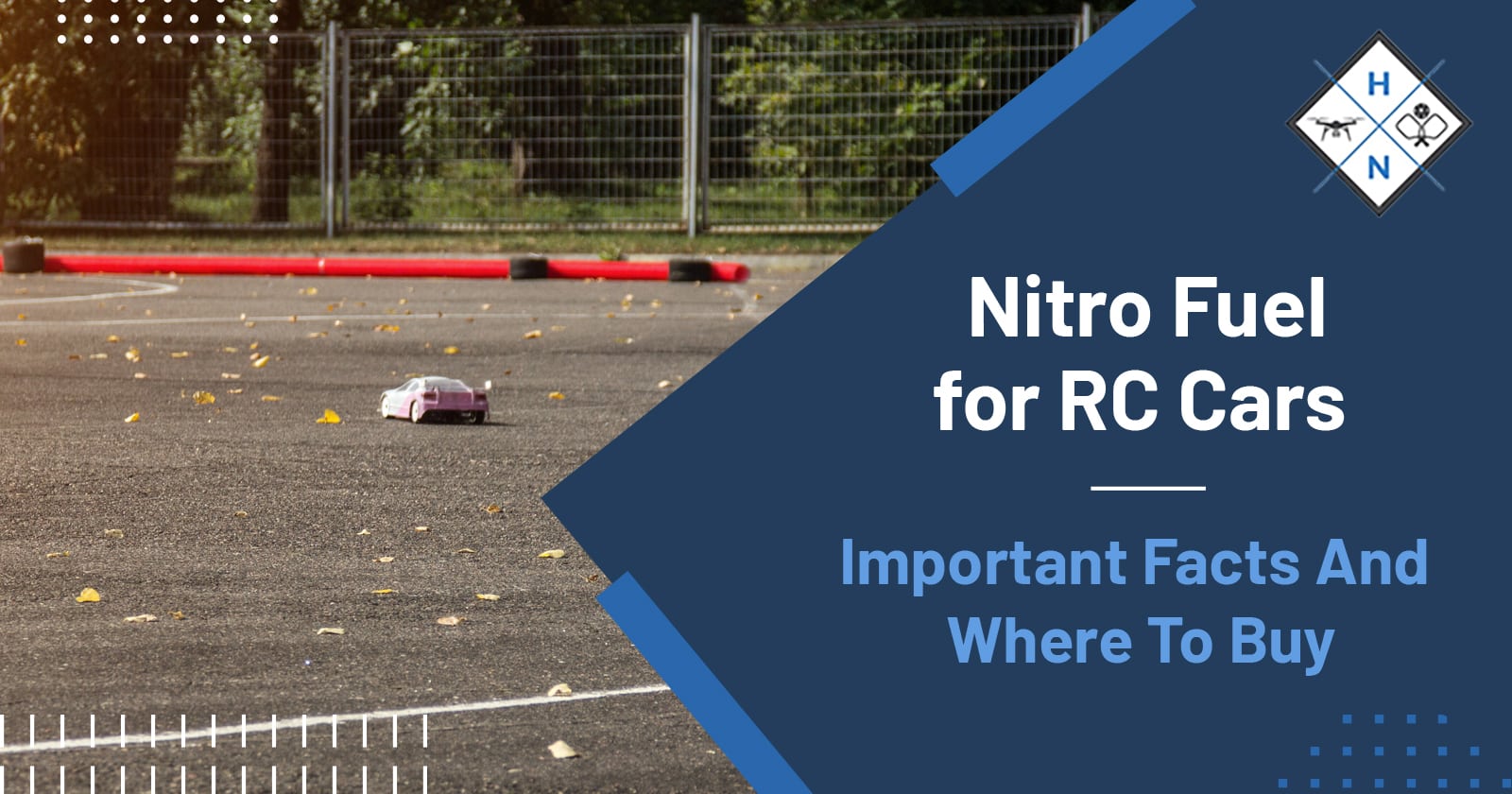RC or Remote-Control cars come in two main types; electric powered and nitro powered. Nitro-powered RC cars refer to those that require nitro fuel as a source of power, while electric-powered RC cars require an electric battery. Professional RC hobbyists prefer nitro-powered RC cars to electric-powered RC cars.
Nitro fuel is a combination of nitromethane, oil, and methanol. It should be treated with care as it is highly flammable. It can soak up moisture from the air, which reduces its shelf life, so you should keep it in a properly sealed container. You can get nitro fuel from any RC product store.
A Nitro RC car can perform more realistically and better than an electric-powered RC car. The nitro fuel delivers and provides speed and power to your RC car.

What Is In Nitro Fuel?
Nitro fuel is also called model fuel or glow fuel, and it is produced by combining nitromethane, oil, and methanol. Nitromethane is usually between 5 to 40%, oil takes up about 8 to 25%, and methanol, 60 to 80%. Other things like fuel dyes and other additives are sometimes added to nitro fuel.
Methanol
Methanol is a type of alcohol, and it is used in preparing antifreeze, fuels, as well as other solvents. Methanol was previously produced from wood, but now, it is produced from natural gas; this is why you will find some methanol termed wood alcohol and others methyl alcohol.
The main ingredient of nitro fuel is methanol, and it takes up about 60 to 80% of the total mix. Methanol is what provides most of the power, and it is what makes the fuel burn during usage. Of all the ingredients used to produce nitro fuel, methanol has the lowest flashpoint, 52 to 54 degrees Fahrenheit.
The flashpoint means that methanol produces ignitable vapors only in those temperatures. Methanol has a higher autoignition temperature of 878 degrees Fahrenheit. If you have wondered why it is advised that nitro fuel be stored properly, it is due to the low flash point of methanol.
Methanol's low flashpoint indicates that it can be a serious fire risk when not handled with care or stored properly. Methanol is more dangerous because it burns with a pale blue flame that is impossible to spot in daylight. So, you must always keep nitro fuel properly stored.
Nitromethane
Nitromethane is an oily, colorless liquid, and its properties are shocking. Nitromethane contains oxygen and nitrous oxide atoms and can replace oxygen to a certain degree due to the extra oxygen. So, nitromethane can sometimes function as oxygen needed for burning fuel.
Nitromethane can generate power to some extent, although it will not be as much as gasoline. Pumping enough nitromethane into the cylinder will generate more power. With nitromethane, you can pump about 2.5 more fuel than usual, although the power produced is not as great.
The autoignition temperature of nitromethane is 784 degrees Fahrenheit, and the flashpoint is 95 degrees Fahrenheit. Nitromethane performs various functions in a nitro RC car. It burns fuel quicker; this results in the production of more power and conversion of higher revolution per minute (RPM).
Nitromethane also makes the engine run smoother and improves idling. It also makes it easy to tune the engine when necessary. Despite nitromethane's various functions and uses, its use is not essential. Using a lot of nitromethane can result in overheating of the engine and excessive wear.
Oil/Lubricant
Most nitro engines in nitro RC cars are two-stroke, so they require a type of lubricant. These lubricants are included in the nitro fuel mixture; they keep the engine and the internal parts in great working condition. However, you should know that not all types of oil can be used as a lubricant.
The oil used as a lubricant in nitro fuel has great viscosity at low temperatures, does not burn at high temperatures, and mixes perfectly well with methanol. The oil must not burn at high temperatures, so it retains its lubrication qualities. The most commonly used lubricant for nitro fuel is synthetic oil and castor oil.
Both oils have pros and cons; castor oil leaves a residue in the nitro engine after usage, but it is a better lubricant. On the other hand, synthetic oil does not have great lubrication qualities like castor oil, but it does not leave a residue. Sometimes, it is best to combine synthetic oil and castor oil to get the best lubrication quality.

Fuel Additives
We mentioned earlier that additives are sometimes added to the nitro fuel to improve it, such as anti-corrosion, anti-foaming, and degumming agents. Nitro fuels are colorless, but many manufacturers add fuel dyes to make them identifiable. This is done for safety purposes, and in some countries, it is mandated that some fuels be dyed.
The most common colors of nitro fuel are red, pink, yellow, blue, and green, although they can be available in other color variations. The fuel dye used does not affect the nitro fuel in any way. However, additives and fuel dyes are not essential in nitro fuels.
How Do You Get Nitro Fuel?
There are two ways of getting nitro fuel; you can either purchase from an RC accessory store or make nitro fuel at home. The former is the easiest way, but it may not always be cost-effective. The latter is time-consuming, but you will have a longer supply of nitro fuel.
To make nitro fuel at home, all you need are pure nitromethane, pure methanol, as well as castor oil. Other tools you will need are a funnel, measuring cups, and a container to store the nitro fuel. Although there can be limitations to purchasing pure nitromethane and methanol, you can also use premixed blends.
You should avoid using the normal 2-stroke engine oil because it does not create a perfect mixture with nitromethane and methanol. Using it will ruin the fuel you produce. Another essential thing is knowing the precise amount of each ingredient, and there is a formula to it.
For example, if you want to make a gallon of nitro fuel, you need to know the right amount of nitromethane, methanol, and oil to use. The U.S. gallon is 128 ounces, so to determine what 20 percent of the batch will be, you will multiply 128 ounces by 20%, which is 25.6 ounces. So, you need 25.6 ounces of nitromethane for a gallon of nitro fuel.
To find out the amount of oil you need, you calculate it with the same formula, 15% of oil multiplied by 128 ounces of fuel results in 19.2 ounces. You will need 19.2 ounces of castor oil to produce 1 gallon of nitro fuel. Next is to figure out the quantity of methanol needed.
Since nitromethane is 20% and castor oil is 15%, methanol will be 65%, multiplying 65% by 128 ounces, giving 83.2 ounces. To produce 1 gallon of nitro fuel, you need 25.6 ounces of nitromethane, 19.2 ounces of castor oil, and 83.2 ounces of methanol.
How Much Does Nitro Fuel Cost?
Nitro fuel is expensive, and one of the major determinants of the price is the location. You can purchase nitro fuel for $70 per gallon and, in other places, $40 per gallon. The cost of nitro fuel is why RC car enthusiasts prefer to make their nitro fuel instead of purchasing it.
Final Thoughts
Nitro fuel can be dangerous, so you need to be extra careful when dealing with it, especially when making your batch. Of all the ingredients in nitro fuel, methanol is the most dangerous and toxic, there are toxic and non-toxic oils, and nitromethane is the least dangerous.
Keep reading: The Best Gas-Powered RC Cars Under $100 [Reviewed]
Shawn Manaher loves to play with new toys and dive into new hobbies. As a serial entrepreneur, work definitely comes first but there is always room for hobbies.

